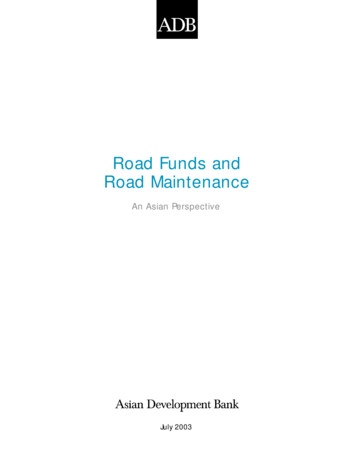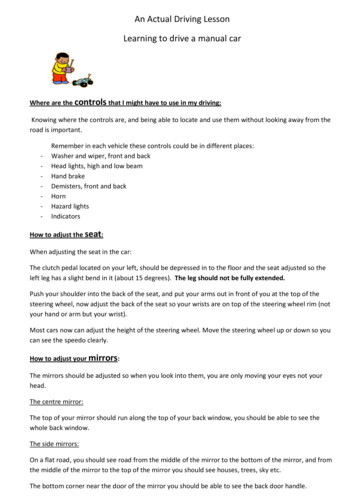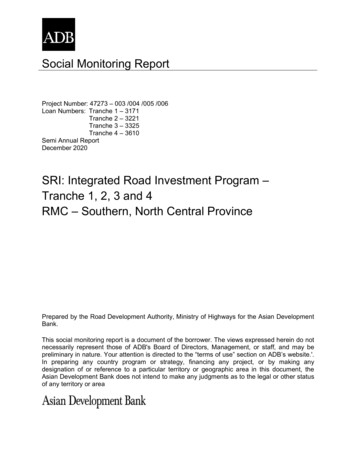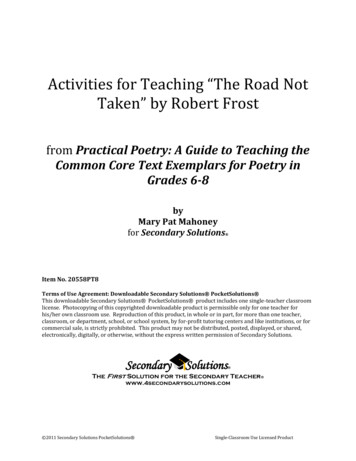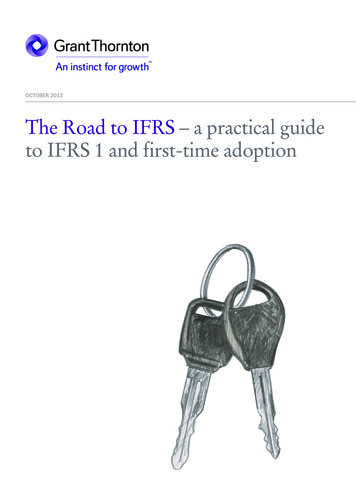
Transcription
OCTOBER 2012The Road to IFRS – a practical guideto IFRS 1 and first-time adoption
Important Disclaimer:This document has been developed as an information resource. It is intended as a guideonly and the application of its contents to specific situations will depend on the particularcircumstances involved. While every care has been taken in its presentation, personnel whouse this document to assist in evaluating compliance with International Financial ReportingStandards should have sufficient training and experience to do so. No person should actspecifically on the basis of the material contained herein without considering and takingprofessional advice. Neither Grant Thornton International Ltd, nor any of its personnel nor anyof its member firms or their partners or employees, accept any responsibility for any errors itmight contain, whether caused by negligence or otherwise, or any loss, howsoever caused,incurred by any person as a result of utilising or otherwise placing any relianceupon this document.
IntroductionThe Road to IFRSThe benefits of global standards are widelyacknowledged with over 100 countries nowapplying International Financial ReportingStandards (IFRSs). Many countries made thisswitch recently while others are still in the processof transition from local GAAP. Experience hasshown that, for companies, the conversion to IFRSsis a major change both for the finance function andfor the wider business. Many more companies willface this challenge in future – due for example tomore countries adopting IFRSs, initial publicofferings and changes of ownership.The International Accounting Standards Board(IASB) recognised the need for guidance some timeago and, in 2003, published IFRS 1 ‘First-timeAdoption of International Financial ReportingStandards’ (IFRS 1). Since then IFRS 1 has beenamended several times.IFRS 1 covers the application of IFRSs in acompany’s first IFRS financial statements. It startswith the basic premise that an entity applies IFRSsfor the first time on a fully retrospective basis.However, acknowledging the cost and complexityof that approach, IFRS 1 then provides numerousexemptions in areas where retrospective applicationwould be too burdensome or impractical. Inplanning the conversion, management must developa detailed and specific understanding of IFRS 1’simplications on their business. Questions toconsider include: when is retrospective restatement required andwhat will this involve? what are the exemptions in IFRS 1 and howshould we decide which to take up? what information is needed in our first IFRSfinancial statements? how does IFRS 1 affect the timing of ourconversion and reporting?Fortunately, the member firms within GrantThornton International Ltd (Grant ThorntonInternational) – one of the world’s leadingorganisations of independently owned andmanaged accounting and consulting firms – havegained extensive insights into the more problematicaspects of first-time adoption of IFRS. GrantThornton International, through its IFRS team,develops general guidance that supports its memberfirms’ commitment to high quality, consistentapplication of IFRSs. We are pleased to share theseinsights by publishing this guide ‘The Road toIFRS – A practical guide to IFRS 1 and first-timeadoption’ (the guide). The guide reflects thecollective experience of Grant ThorntonInternational’s IFRS team and member firm IFRSexperts. It explains IFRS 1’s key implementationissues and includes interpretational guidance in themore problematic areas. The guide also includesseveral examples illustrating the Standard’sdisclosure and presentation requirements. We havenot attempted to cover every possible transactionbut have focused instead on areas that have provedto be challenging in practice.Latest version of IFRS 1IFRS 1 has been amended many times since 2003 inorder to clarify issues raised in practice, introducenew exemptions and accommodate changes toother IFRSs. In this guide, subject to an exceptionfor IFRS 9 ‘Financial Instruments’ (see note below),references and examples are based on the latestversions as at June 2012 of: IFRS 1 all other IFRSs, including those that are not yetin mandatory effect.The road to IFRS i
Important noteIAS 39 and IFRS 9The IASB is part way through a process of replacingIAS 39 ‘Financial Instruments: Recognition andMeasurement’ (IAS 39) with IFRS 9 ‘FinancialInstruments’ (IFRS 9). IFRS 9 is being developed instages and is not yet complete. In addition, somechanges are expected to be made to the chapters ofIFRS 9 that have already been published. The currentversion of IFRS 9 is mandatory for annual periodsbeginning on or after 1 January 2015 (early applicationis permitted).In view of the status of IFRS 9 and its effectivedate, the guide has been written on the assumptionthat a first-time adopter will apply IAS 39 rather thanIFRS 9. An entity that adopts IFRS 9 should referdirectly to the published version of IFRS 1 whereapplicable.Using the guideThe guide is organised as follows: Section A addresses the scope and objectives ofIFRS 1 and summarises its main principles Section B discusses the implications ofpreparing an IFRS opening statement offinancial position, focusing on recognition andmeasurement principles (IFRS accountingpolicies) and the date of transition Section C discusses the exemptions to fullretrospective application of IFRSs illustratingthe practical implications with several examples Section D addresses the presentation anddisclosure requirements of IFRS 12 The road to IFRS Appendix I includes a list of mandatory andoptional exemptions from full retrospectiveapplication of IFRSs Appendix II provides further applicationguidance.The focus of this guide is on the accounting aspectsof first-time adoption. Adopting IFRSs goesbeyond pure accounting – affecting for exampleinformation systems, contractual arrangements andcommunication to investors and other stakeholders.In planning its transition, management shouldensure that sufficient, timely attention is given bothto the accounting and to these broader businessimplications.Grant Thornton International LtdOctober 2012
ContentsIntroductioniA. IFRS 1 principles in brief1 Background and objectives2 When does IFRS 1 apply?2.1 First IFRS financial statements2.2 Application of IFRS 1 more than once2.3 Interim financial reports112233B. Opening statement of financial position1 Preparing an opening statement of financial position1.1 The date of transition1.2 Recognition and measurement in the opening statement of financial position2 Accounting policies2.1 Transitional provisions in other IFRSs do not apply2.2 Changes to IFRSs effective later than the first reporting date2.3 Interim financial reports3 Where does the adjustment entry go?444666678C. Exemptions from full retrospective application1 Prospective application2 Optional exemptions2.1 Business combinations2.2 Goodwill2.3 Deemed cost2.4 Employee benefits2.5 Cumulative translation differences2.6 Compound financial instruments2.7 Assets and liabilities of subsidiaries, associates and joint ventures2.8 Designation of previously recognised financial instruments2.9 Share-based payment transactions2.10 Insurance contracts2.11 Decommissioning liabilities included in the cost of property, plant and equipment2.12 Leases2.13 Fair value measurement of financial assets or financial liabilities at initial recognition2.14 Service concession arrangements2.15 Borrowing costs2.16 Investments in subsidiaries, joint ventures and associates2.17 Transfers of assets from customers2.18 Extinguishing financial liabilities with equity instruments2.19 Stripping costs in the production phase of a surface mine2.20 Severe hyperinflation2.21 Joint 33333434
34Mandatory exemptions3.1 Derecognition of financial assets and financial liabilities3.2 Hedge accounting3.3 Estimates3.4 Consolidation and non-controlling interests3.5 Government loansFuture developments36363637384041D. Presentation and disclosure1 General requirements2 Primary statements and comparative information2.1 Historical summaries2.2 Related notes3 Explanation of transition to IFRSs3.1 Reconciliations of equity3.2 Reconciliation of total comprehensive income3.3 Example of reconciliations3.4 Presentation differences3.5 Statement of cash flows3.6 Impairments4 Previous GAAP errors5 Other disclosures6 IFRS 1 exemptions applied7 Interim financial reports42424243434444454649494950505051Appendix I. Current effective exemptions1 Mandatory exemptions2 Optional exemptions3 Optional short term exemptions53535454Appendix II. Selected application issues1 Introduction2 Intangible assets – capitalisation of development costs3 Leases4 Financial instruments4.1 Recognition4.2 Measurement4.3 Presentation of financial instruments as liabilities or equity4.4 Embedded derivatives5 Hedge accounting5.1 Reflecting hedges in the opening statement of financial position5.2 Subsequent accounting after the date of transition6 Income taxes6.1 IAS 12 initial recognition exemption6.2 Deferred tax on share options granted before 7 November 20026.3 Intangible assets acquired in a pre-transition date business combination7 Business combinations7.1 Double-counting of fair value adjustments within goodwill7.2 Intangible assets acquired in a past business combination8 Venture capital organisations and investments in associates9 Pre-transition share-based payments costs565656575757575959606064666667676868687070
A. IFRS 1 principles in briefIFRS 1 sets out the procedures that a first-time adopter must follow on first-time adoption of IFRSs.This section discusses the objectives and scope of the standard and also summarises the main principlesin IFRS 1.IFRS 1 at a glanceA. The main principle of IFRS 1 is to present the first IFRS financial statements using the accounting policieseffective at the end of the first IFRS reporting period throughout all periods presented. For example, acompany using IFRSs for the first time in 2012 with a December year-end would use the accounting policies inforce at 31 December 2012 and apply those policies retrospectively. Therefore the financial statements arepresented as if the first-time adopter had always presented IFRS financial statements (important exemptionsapply).B. The first-time adopter establishes its date of transition, which is defined as the beginning of the earliest periodfor which an entity presents full comparative information under IFRSs in its first IFRS financial statements.C. At the date of transition the first-time adopter prepares an opening statement of financial position. This is thestarting point for its accounting under IFRSs.D. In the opening statement of financial position, the first-time adopter applies its IFRS accounting policies inrecognising and measuring all assets and liabilities, and if appropriate reclassifies items recognised underprevious generally accepted accounting principles (GAAP) as another type of asset, liability or component ofequity. The accounting policies are based on IFRSs effective at the end of its first IFRS reporting period(important exemptions apply).E. In preparing the opening statement of financial position, the first-time adopter may choose the optionalexemptions from retrospective application. The first-time adopter applies the mandatory exemptions in allapplicable cases.F. A first-time adopter prepares reconciliations between previous GAAP and IFRSs, and discloses thesereconciliations in its first IFRS financial statements (and interim reports, if applicable). The entity complies withother note disclosures in IFRS 1 in addition to those required by other IFRSs.1 Background and objectivesIFRS 1 was first published in June 2003. It has been amended many times since in order to clarify issuesraised in practice, introduce new exemptions and accommodate changes to other IFRSs (including anextensive reorganisation in November 2008). It sets out most of the transitional requirements that an entityapplies when it first adopts IFRSs and also specifies various disclosures to explain the effects of transitionto IFRSs.The objectives of IFRS 1 are to ensure that an entity’s first IFRS financial statements (or interim reportsthat cover part of the first IFRS reporting period) contain information that: is transparent for users is comparable over all periods presented provides a suitable starting point for accounting under IFRSs and can be generated at a cost that does not exceed the benefits to users.The road to IFRS: Section A 1
Put another way, IFRS 1 aims to strike a balance between the ideal of full retrospective application (ieapplying IFRSs in the first year as though the entity has always done so), and the cost of applying thatapproach. IFRS 1 sets out a limited but significant range of exemptions from retrospective applicationwhich are very important in practice. These are discussed in section C.2 When does IFRS 1 apply?IFRS 1.2 states that:“An entity shall apply this IFRS in:(a) its first IFRS financial statements; and(b) each interim financial report, if any, that it presents in accordance with IAS 34 ‘Interim Financial Reporting’ forpart of the period covered by its first IFRS financial statements.”2.1 First IFRS financial statementsAn entity applies IFRS 1 in its first IFRS financial statements (and each interim financial report that coverspart of the period of those first IFRS financial statements). It is therefore essential to identify thosefinancial statements, which are defined as:“The first annual financial statements in which an entity adopts International Financial Reporting Standards(IFRSs), by an explicit and unreserved statement of compliance with IFRSs” (IFRS 1.Appendix A) [emphasis added].The most common example of an entity’s first IFRS financial statements is when an entity presented itsmost recent financial statements under local GAAP or other requirements that differ from IFRSs. This willbe the case for most first-time adopters.The standard includes some other examples of first IFRS financial statements, which emphasise theimportance of the explicit and unreserved statement of compliance with IFRSs. For example, IFRS 1applies where the entity presented its most recent financial statements in conformity with IFRSs in allrespects, except that the financial statements did not contain an explicit and unreserved statement ofcompliance with IFRSs. Other examples are shown below:Example A.1: First IFRS financial statementsA. Entity A did not present financial statements for previous periods. Entity A’s annual financial statements includean explicit and unreserved statement of compliance with IFRSs. The financial statements of entity A are theentity’s first IFRS financial statements, and entity A applies IFRS 1 (IFRS 1.3(d)).B. Entity B’s previous financial statements contained an explicit statement of compliance with some, but not all,IFRSs. The financial statements of entity B for the year contain an explicit and unreserved statement ofcompliance with all IFRSs. The financial statements for the year are the entity’s first IFRS financial statementsand entity B applies IFRS 1 (IFRS 1.3(a)(iii)).C. Entity C’s financial statements for the previous year contained an explicit and unreserved statement ofcompliance with IFRSs, but the auditors presented a qualified audit report. The financial statements of entity Cfor this year are not the entity’s first IFRS financial statements, and IFRS 1 does not apply (IFRS 1.4(c)).D. Entity D presented its prior year financial statements under national requirements and those financialstatements contained an explicit and unreserved statement of compliance with IFRSs. This year’s financialstatements also contain an explicit and unreserved statement of compliance with IFRSs. The financialstatements of entity D for this year are not the entity’s first IFRS financial statements, and IFRS 1 does notapply (IFRS 1.4(b)).The examples make clear that the definition is applied strictly. As noted above, making an explicit andunreserved statement of compliance with IFRSs is a key factor, along with the absence of this statement inthe previous financial statements. It follows that a set of financial statements can only be the first IFRSfinancial statements if they comply with all requirements in IFRSs (including disclosures).2 The road to IFRS: Section A
2.2 Application of IFRS 1 more than onceAn entity applies IFRS 1 when it adopts IFRSs for the first time. It therefore applies IFRS 1 in its transitionto IFRSs and cannot generally apply it again. However, an entity might have adopted IFRSs in the past butlater switched to another financial reporting framework (eg local generally accepted accounting practice orGAAP). If the entity subsequently re-adopts IFRSs in a future period it can either: apply IFRS 1 or apply IFRSs retrospectively in accordance with IAS 8 ‘Accounting Policies, Changes in AccountingEstimates and Errors’ (IAS 8) as if the entity had never stopped applying IFRSs, in which case it shoulddisclose the reason why it has elected to apply IFRSs retrospectively.Irrespective of whether the entity decides to apply IFRS 1 or IAS 8, it shall disclose the reason why itpreviously stopped applying IFRSs and the reason why it is re-adopting IFRSs (IFRS 1.23A).2.3 Interim financial reportsIt is important to note that a first-time adopter’s interim financial reports for part of the period covered bythe first IFRS financial statements (for example the first six months) presented under IAS 34 ‘InterimFinancial Reporting’ (IAS 34) should also follow the requirements in IFRS 1. However, IFRS 1 does notrequire a first-time adopter to present an interim report, it only requires additional disclosures in theinterim report if one is presented. These disclosure requirements are further discussed in section D.The road to IFRS: Section A 3
B. Opening statement of financialpositionSummary of requirementsA. The first-time adopter establishes its date of transition to IFRSs, which is defined as the beginning of theearliest period for which an entity presents full comparative information under IFRSs in its first IFRS financialstatements.B. At the date of transition the first-time adopter prepares an opening statement of financial position. This is thestarting point for its accounting under IFRSs.C. In the opening statement of financial position, the first-time adopter applies its IFRS accounting policies inrecognising and measuring all assets and liabilities, and if appropriate reclassifies items recognised underprevious GAAP as another type of asset, liability or component of equity (subject to important exemptions). Theaccounting policies are based on IFRSs effective or available for early adoption at the end of its first IFRSreporting period. For interim reports, we believe the policies should be based on IFRSs in existence at the dateof authorisation of the report.1 Preparing an opening statement of financial positionThe requirement for an opening statement of financial position is stated in IFRS 1.6:“An entity shall prepare and present an opening IFRS statement of financial position at the date of transition toIFRSs. This is the starting point for its accounting in accordance with IFRSs.”This opening statement of financial position is prepared based on IFRSs in mandatory force (oravailable for early application) at the end of the first annual reporting period under IFRSs, except whereIFRS 1 permits or requires otherwise.1.1 The date of transitionThe date of transition is the starting point for the entity’s accounting under IFRSs. The date of transition isdefined in IFRS 1 as:“The beginning of the earliest period for which an entity presents full comparative information under IFRSs in itsfirst IFRS financial statements” (IFRS 1.Appendix A) [emphasis added]For companies presenting only one year of full comparative information, the date of transition will bethe beginning of the (only) full comparative period. Consider the following example:4 The road to IFRS: Section B
Example B.1: The date of transition201020112012Previous GAAP financial statementsFirst IFRS financial statementsDate oftransitionIFRS interimreportEnd of first IFRSreporting periodThe first-time adopter prepares its first IFRS financial statements at 31 December 2012 (the end of itsfirst IFRS annual reporting period). For the 2011 and previous annual periods the first-time adopterpresented its financial statements under national GAAP. The first-time adopter prepares one year of fullcomparative information in accordance with stock exchange and IFRSs requirements. The date oftransition is determined as 1 January 2011 (the beginning of the earliest comparative period for whichan entity presents full comparative information). Under stock exchange requirements the first-timeadopter is required to present an interim report under IFRSs at least every 6 months. The first-timeadopter presents its interim report for the period 1 January 2012 to 30 June 2012, which is part ofthe period for its first IFRS financial statements. This interim report is prepared under IAS 34 ‘InterimFinancial Reporting’. To comply with IFRS 1, the first-time adopter presents additional information tothat required in IAS 34 for each interim report of the first year presented under IFRSs (IFRS 1.32 – 33).Presenting one year of full comparative information is the norm under IFRSs. It should however be notedthat IAS 1 ‘Presentation of Financial Statements’ (IAS 1) requires an additional statement of financialposition in a regular set of IFRS financial statements at the beginning of the earliest comparative periodpresented when an entity makes a retrospective restatement. In a first-time adopter’s first IFRS financialstatements, IFRS 1.21 requires presentation of at least two comparative statements of financial position,and one comparative period for the other primary financial statements.IFRS 1 paragraph 21To comply with IAS 1, an entity’s first IFRS financial statements shall include at least three statements of financialposition, two statements of profit or loss and other comprehensive income, two separate statements of profit orloss (if presented), two statements of cash flows and two statements of changes in equity and related notes.This additional statement of financial position does not bring forward the date of transition. This is because thatdate is defined as the beginning of the earliest period for which an entity presents full comparative informationunder IFRSs.The requirement to present an additional statement of financial position applies to all first IFRS financialstatements where IAS 1 is applied. This is discussed further in section D.2.If an entity is required to present full comparative information for two periods, the date of transition isbrought forward. Consider example B.2 below.Example B.2: Two full comparative periods required by national lawEntity A is presenting its first IFRS financial statements in 2012 with a reporting date of 31 December 2012.Entity A is required by national law to present full comparative information under IFRSs for two annual periods. Thedate of transition is 1 January 2010, which is the beginning of the earliest period where an entity presents fullcomparative information under IFRSs. In this situation, the transition date is 3 years before the reporting datebecause of the requirement by national law for two full comparative periods.The road to IFRS: Section B 5
1.2 Recognition and measurement in the opening statement of financial positionThe general rule in IFRS 1 is that a first-time adopter develops accounting policies that conform withIFRSs effective at the end of its first IFRS reporting period. It then applies those policies both in itsopening statement of financial position and throughout all periods presented. In the absence of anyrelaxation of this default approach, converting the opening statement of financial position from localGAAP to IFRSs would require a complete, retrospective restatement of assets, liabilities and equity inconformity with the version (or versions) of IFRSs in force at the first reporting date. However, IFRS 1permits or requires numerous exemptions to the general rule. These exemptions, which are of greatpractical importance, are considered in section C.When these exemptions do not apply, IFRS 1.10 states that in preparing the opening statement offinancial position a first-time adopter: recognises all assets and liabilities whose recognition is required by IFRSs does not recognise items as assets or liabilities if IFRSs do not permit such recognition reclassifies items that it recognised under previous GAAP as one type of asset, liability or componentof equity but are a different type of asset, liability or component of equity under IFRSs and applies IFRSs in measuring all recognised assets and liabilities.In other words, in the absence of an exemption, the opening statement of financial position is prepared as ifthe first-time adopter had always applied the currently effective version of IFRSs.2 Accounting policiesIn preparing the opening statement of financial position a first-time adopter applies accounting policiesthat comply with all IFRSs effective at the end of its first IFRS reporting period. It uses these accountingpolicies throughout all periods presented in the first IFRS financial statements (IFRS 1.7). In other words, afirst-time adopter is not permitted to apply different versions of IFRSs that were effective at earlier dates(IFRS 1.8). In the absence of an IFRS that specifically applies to a transaction, the hierarchy in IAS 8 forselection of accounting policies applies both for the interim reports and for the annual financial statements.2.1 Transitional provisions in other IFRSs do not applyTransitional and effective date provisions in other IFRSs“Transitional provisions” in IFRSs are requirements governing how an entity moves from a previous version of anIFRS to the latest version. Where a new or revised IFRS does not contain transition provisions, the general rules inIAS 8 apply. These can be summarised as retrospective application subject to some practicality constraints.Where a new or revised IFRS includes transitional requirements, these typically specify the extent to whichprospective rather than retrospective application is required and sometimes cover more detailed matters.Transitional provisions should not be confused with effective date provisions (see paragraph 2.2 below).Effective date provisions set out when (rather than how) a new or revised IFRS is applied. They typically specifythat the new requirement must be applied in an annual period beginning on or after a certain date. Effective daterequirements also address whether early application is permitted and any conditions attached to early adoption.For example, an entity that early adopts one new requirement may also be required to adopt other relatedrequirements.The transitional provisions in other IFRSs apply only to entities that already apply IFRSs. The transitionalprovisions do not apply to a first-time adopter except where specified in IFRS 1 (IFRS 1.9).2.2 Changes to IFRSs effective later than the first reporting dateIn many cases, a first-time adopter will find that more than one IFRSs (or version of an IFRSs) is availableat the end of the first IFRS reporting period. This occurs when the IASB has issued a new or revisedstandard which is not yet mandatory at that date but which permits early application. In this situation, afirst-time adopter is permitted to develop its accounting policies using either the previous IFRS or the newIFRS (or version).6 The road to IFRS: Section B
For example, in May 2011 the IASB published IFRS 10 ‘Consolidated Financial Statements’ (IFRS 10),IFRS 11 ‘Joint Arrangements’ (which replaces IAS 31 ‘Interests in Joint Ventures’), IFRS 12 ‘Disclosure ofInterests in Other Entities’, an amended version of IAS 27 ‘Separate Financial Statements’ and an amendedversion of IAS 28 ‘Investments in Associates and Joint Ventures’ (the ‘consolidation package’). Thepackage takes mandatory effect for annual periods beginning on or after 1 January 2013. Earlier applicationis permitted provided that the entity applies the entire package.If a first-time adopter presents its first IFRS financial statements at 31 December 2012, it can applythe previous consolidation standards. Alternatively, it can apply the consolidation package in its entirety.IFRS 1.8 confirms that a first-time adopter may apply a new IFRS that is not yet mandatory if that IFRSpermits early application.In practice, a first-time adopter will often find it more convenient to apply the new standard or thelatest version of a standard to avoid having an accounting policy change in the following year. However, insome circumstances using an earlier standard or version (when permitted) might be preferable. The optionsare illustrated in the following example:Example B.3: Impact of new standardsBackgroundEntity A is a first-time adopter and its first IFRS reporting period ends on 31 December 2012. Entity A presentsfull comparative information in those financial statements for one year. Therefore, its date of transition to IFRSs is1 January 2011. Entity A presented financial statements under its previous GAAP annually to 31 December eachyear up to, and including, 31 December 2011.Entity A is required to apply the IFRSs effective for periods ending on 31 December 2012 in preparing andpresenting:(a) its opening IFRS statement of financial position at 1 January 2011, and(b) its statement of financial position for 31 December 2012, and statements of comprehensive income, changesin equity and cash flows for the year to 31 December 2012 and related notes (including comparative information).If a new IFRS is not yet mandatory but permits early application, entity A is permitted, but not required, to apply
Introduction i A. IFRS 1 principles in brief 1 1 Background and objectives 1 2 When does IFRS 1 apply? 2 2.1 First IFRS financial statements 2 2.2 Application of IFRS 1 more than once 3 2.3 Interim financial reports 3 B. Opening statement of financial position 4 1 Preparing an opening statement of financial position 4 1.1 The date of transition 4 1.2 Recognition and measurement in the opening .


